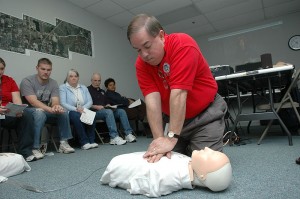 New guidelines from the American Heart Association outlining the steps for CPR (cardiopulmonary resuscitation) instruct rescuers to begin with hard, fast chest presses prior to giving victims mouth-to-mouth.
New guidelines from the American Heart Association outlining the steps for CPR (cardiopulmonary resuscitation) instruct rescuers to begin with hard, fast chest presses prior to giving victims mouth-to-mouth.
The change differs from old CPR training, in that rescuers are no longer supposed to give two breaths first, then alternate with 30 presses, which co-author of the guidelines, Dr. Michael Sayre, states took time and delayed chest presses, vital for keeping the blood circulating. Instead of following the steps “A-B-C”, or “Airway, Breathing, and Compressions,” the new process should follow the acronym “C-A-B”, or “Compressions, Airway, and Breathing.” New specifications also pertain to the depth at which rescuers should push on victim’s chests, as deeper compressions of at least 2 inches in adults are advised.
By keeping promotional first aid kits with the most up-to-date life-saving techniques accessible to everyone in your office environment, your company may prevent future workplace accidents. Keep reading for complete step-by-step CPR directions…
1. Call 911 or ask someone else to do so.
2. Try to get the person to respond; if he is unresponsive, roll the person on his or her back.
3. Start chest compressions. Place the heel of your hand in the center of the victim’s chest. Rest your other hand on top of the first and interlace your fingers.
4. Press down so you compress the chest at least 2 inches in adults and children and 1.5 inches in infants. ”One hundred times a minute or even a little faster is optimal,” Sayre says. (Or approximately to the beat of the Bee Gee’s song “Stayin’ Alive.”)
5. If you’ve been trained in CPR, you can now open the airway with a head tilt and chin lift.
6. Pinch the victim’s nose closed. Take a normal breath, cover the victim’s mouth with yours (creating an airtight seal), and then give two, one-second breaths and watch for the chest to rise.
7. Continue to administer compressions and breaths — 30 compressions, followed by two breaths — until help arrives.
(from http://www.webmd.com/news/20101015/new-cpr-guidelines-chest-compressions-first)
Dana
Team Lead- Social Media
